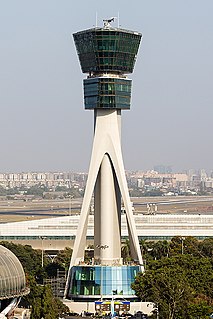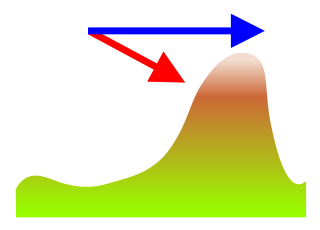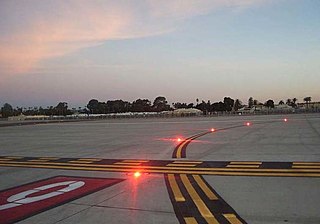
Air traffic control (ATC) is a service provided by ground-based air traffic controllers who direct aircraft on the ground and through a given section of controlled airspace, and can provide advisory services to aircraft in non-controlled airspace. The primary purpose of ATC worldwide is to prevent collisions, organize and expedite the flow of air traffic, and provide information and other support for pilots. In some countries, ATC plays a security or defensive role, or is operated by the military.

Norfolk International Airport is seven miles (11 km) northeast of downtown Norfolk, an independent city in Virginia, United States. It is owned and operated by the Norfolk Airport Authority: a bureau under the municipal government. The airport serves the Hampton Roads metropolitan area of southeast Virginia as well as northeast North Carolina. Despite its name, the airport does not have any international destinations.

Kalamazoo/Battle Creek International Airport is a county-owned public airport 3 miles (4.8 km) southeast of Kalamazoo, in Kalamazoo County, Michigan, USA. The airport is located approximately 20 miles (32 km) west of the city of Battle Creek. It is included in the Federal Aviation Administration (FAA) National Plan of Integrated Airport Systems for 2017–2021, in which it is categorized as a non-hub primary commercial service facility.

A ground proximity warning system (GPWS) is a system designed to alert pilots if their aircraft is in immediate danger of flying into the ground or an obstacle. The United States Federal Aviation Administration (FAA) defines GPWS as a type of terrain awareness warning system (TAWS). More advanced systems, introduced in 1996, are known as enhanced ground proximity warning systems (EGPWS), a modern type of TAWS.

Aviation safety is the study and practice of managing risks in aviation. This includes preventing aviation accidents and incidents through research, educating air travel personnel, passengers and the general public, as well as the design of aircraft and aviation infrastructure. The aviation industry is subject to significant regulation and oversight.
Airport Surface Detection Equipment, Model X, or ASDE-X, is a runway-safety tool that enables air traffic controllers to detect potential runway conflicts by providing detailed coverage of movement on runways and taxiways. By collecting data from a variety of sources, ASDE-X is able to track vehicles and aircraft on airport surfaces and obtain identification information from aircraft transponders.

Runway Status Lights (RWSL) are a visual alerting system installed in some airport taxiways and runways for the purpose of collision-avoidance. When illuminated, red high-intensity LEDs indicate the presence of another vehicle either departing, occupying, or landing on an active runway. RWSL systems are fully-automated and intended to alert aircrews and ground vehicle operators of a potential runway incursion hazard. They operate as an additional layer of safety, independent of human-issued air traffic control clearances.

A runway excursion is a runway safety incident where an aircraft makes an inappropriate exit from the runway. Runway excursions include runway overruns, where an aircraft is unable to stop before it reaches the end of the runway. Runway excursions can happen because of pilot error, poor weather, or a fault with the aircraft.

In aviation, a terrain awareness and warning system (TAWS) is generally an on-board system aimed at preventing unintentional impacts with the ground, termed "controlled flight into terrain" accidents, or CFIT. The specific systems currently in use are the ground proximity warning system (GPWS) and the enhanced ground proximity warning system (EGPWS). The U.S. Federal Aviation Administration (FAA) introduced the generic term TAWS to encompass all terrain-avoidance systems that meet the relevant FAA standards, which include GPWS, EGPWS and any future system that might replace them.

A runway incursion is an aviation incident involving improper positioning of vehicles or people on any airport runway or its protected area. When an incursion involves an active runway being used by arriving or departing aircraft, the potential for a collision hazard or Instrument Landing System (ILS) interference can exist. At present, various runway safety technologies and processes are commonly employed to reduce the risk and potential consequences of such an event.
The Capstone Program was a United States government-funded aviation safety program for the state of Alaska, primarily focusing on rural areas of the state. This joint effort – between the Federal Aviation Administration (FAA), the Alaska Pilot's Association, commercial operators, the University of Alaska, MITRE Corporation, some avionics manufacturers and individual pilots – cut the accident rate in the eastern part of Alaska by around 40%.

A low-level windshear alert system (LLWAS) measures average surface wind speed and direction using a network of remote sensor stations, situated near runways and along approach or departure corridors at an airport. Wind shear is the generic term for wind differences over an operationally short distance which encompass meteorological phenomena including gust fronts, microbursts, vertical shear, and derechos.
A runway safety area (RSA) or runway end safety area (RESA) is defined as "the surface surrounding the runway prepared or suitable for reducing the risk of damage to airplanes in the event of an undershoot, overshoot, or excursion from the runway."

The 2007 San Francisco International Airport runway incursion occurred around 1:36 p.m. PDT on May 26, 2007 when SkyWest Airlines Flight 5741, an Embraer EMB 120 Brasilia turboprop aircraft, nearly collided with Republic Airways Flight 4912, an Embraer 170 Regional Jet, at the intersection of Runways 1L and 28R at San Francisco International Airport (SFO) in South San Francisco, California.
The Next Generation Air Transportation System (NextGen) is an ongoing modernization project of the United States National Airspace System (NAS). The U.S. Federal Aviation Administration (FAA) began work on NextGen improvements in 2007 and plans to have all major components in place by 2025.

Automatic Dependent Surveillance–Broadcast (ADS–B) is a surveillance technology in which an aircraft determines its position via satellite navigation or other sensors and periodically broadcasts it, enabling it to be tracked. The information can be received by air traffic control ground stations as a replacement for secondary surveillance radar, as no interrogation signal is needed from the ground. It can also be received by other aircraft to provide situational awareness and allow self-separation. ADS–B is "automatic" in that it requires no pilot or external input. It is "dependent" in that it depends on data from the aircraft's navigation system.
Runway safety is concerned with reducing harm that could occur on an aircraft runway. Safety means avoiding incorrect presence (incursion) of aircraft, inappropriate exits (excursion) and use of the wrong runway due to confusion. The runway condition is a runway's current status due to meteorological conditions and air safety.

On July 7, 2017, an Airbus A320-211 operating as Air Canada Flight 759 was nearly involved in an accident at San Francisco International Airport in San Mateo County, California, United States. The flight, which originated at Toronto Pearson International Airport, had been cleared by air traffic control to land on runway 28R and was on final approach to land on that runway; however, instead of lining up with the runway, the aircraft had lined up with the parallel taxiway, on which four fully loaded and fueled passenger airplanes were stopped awaiting takeoff clearance. The flight crew initiated a go-around prior to landing, after which it landed without further incident. The aircraft on the taxiway departed for their intended destinations without further incident. The subsequent investigation by the National Transportation Safety Board (NTSB) determined that the Air Canada airplane descended to 59 feet (18 m) above the ground before it began its climb, and that it missed colliding with one of the aircraft on the taxiway by 14 feet (4.3 m).
Airport Surface Surveillance Capability (ASSC) is a runway-safety tool that displays aircraft and ground vehicles on the airport surface, as well as aircraft on approach and departure paths within a few miles of the airport. The tool allows air traffic controllers and air crew in cockpits equipped with Automatic Dependent Surveillance-Broadcast (ADS-B) to detect potential runway conflicts by providing detailed coverage of movement on runways and taxiways. By collecting and fusing data from a variety of sources, ASSC is able to track vehicles and aircraft on airport surfaces and obtain identification information from aircraft ADS-B transponders.

The Commercial Aviation Safety Team (CAST) is a US aviation safety partnership between regulators, manufacturers, operators and professional unions, research groups, international organizations to further enhance safety. Founded in 1997 with a goal to reduce the fixed-wing commercial aviation fatality rate in the United States by 80 percent by 2007. By 2007 CAST was able to report that by implementing safety enhancements, the fatality rate of commercial air travel in the United States was reduced by 83 percent. In 2008, the Commercial Aviation Safety Team (CAST) won the Collier Trophy. In 2010, CAST envisioned a further reduction in fatalities of fifty percent by 2025.












